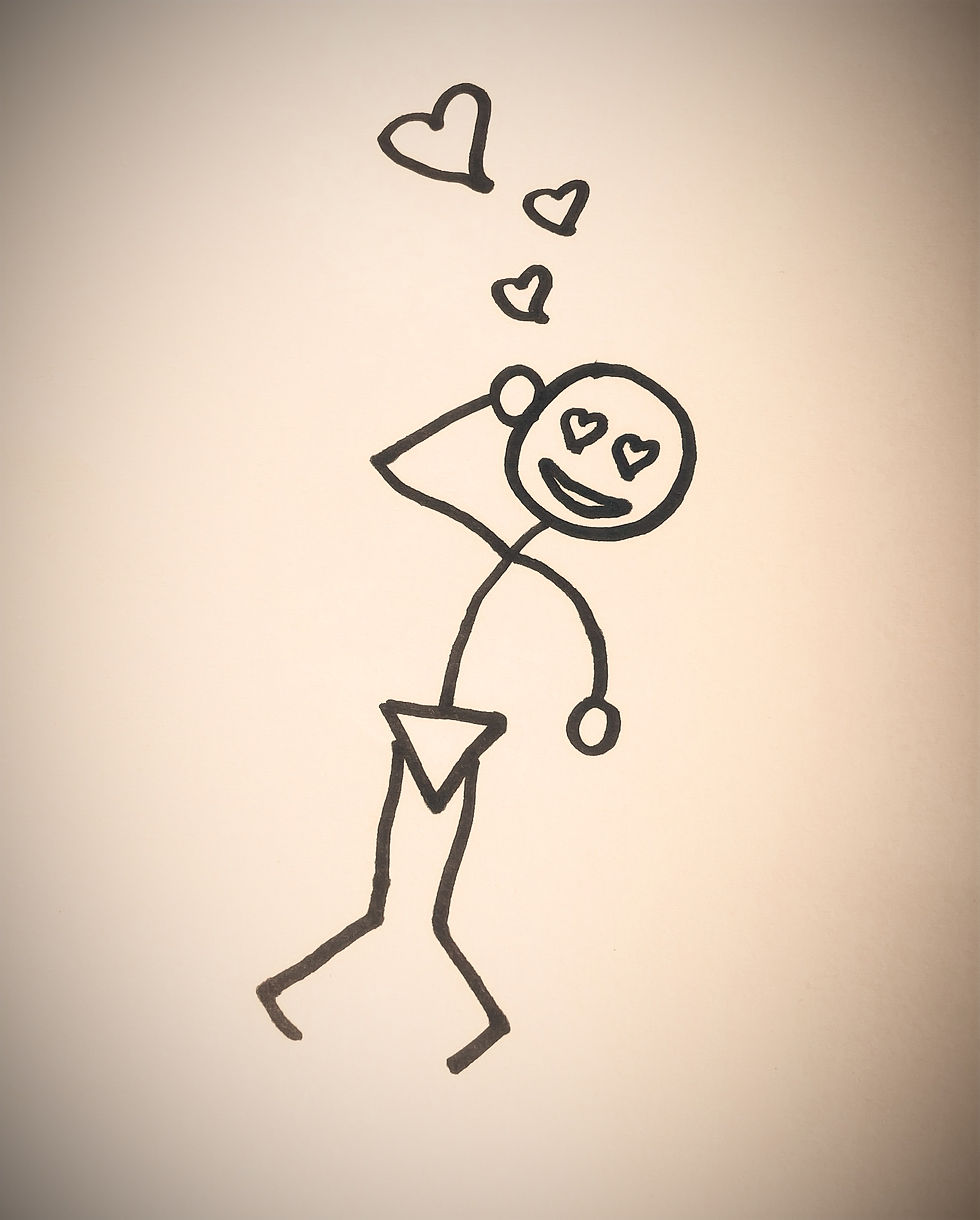Going Weak at the Knees may not always be a sign of true love…
- susanherdman
- Feb 2, 2022
- 4 min read

Ahhhh, February – a month that is famously known by happy couples for Valentine’s Day and infamously known as Single Awareness Day (with the unfortunate acronym S.A.D.) by those who are unattached.
Have you ever “gone weak at the knees” after spotting a handsome hunk or buxom babe at the bar? And just when you try to work up the nerve to talk to them, your body seems to produce all the wrong symptoms such as palms sweating, hands trembling, heart racing, throat clenching, and it seems virtually impossible to string two words together? I know I have…
What’s going on?
During the initial “attraction” stage of love, your brain is being flooded with a cocktail of hormones and neurotransmitters that are involved in the sympathetic nervous system – which generates the “fight, flight, or freeze” response (1)! As your body prepares for “action”, more cortisol is released (giving way to an increased state of alertness – ie nervousness!) (1,2). A release of norepinephrine stimulates this fight, flight, or freeze response and creates all those nerve-wracking sensations including “going weak at the knees” (1,2).
Talk to your physiotherapist about how diaphragmatic breathing may help you get your nervous system back under control (3) (so you can work up the nerve to ask your beloved one out!!). Diaphragmatic breathing has been shown to increase heart rate variability (which is a good thing!), indicating a decrease in the “volume” of the sympathetic nervous system and an increase in the “volume” of the parasympathetic nervous system’s effect on the heart (3,4).

Other causes for Knee Weakness:
But if you’re still struggling with “going weak at the knees”, there may be some other non-lovey-dovey reasons for why your knees are giving out on you.
Are you over 50 and have noticed increased stiffness into your knees? You may be experiencing osteoarthritis (OA). Physiotherapy has been shown to improve function and decrease pain for those with knee OA (5).
Besides feeling like your knee is “giving out” on you, have your knees ever locked and/or do you have trouble pivoting on that knee? It’s possible that the wedge-shaped cartilage (meniscus) in your knee may be irritated or torn. Getting your physiotherapist to assess for this may aid your recovery (6).
Did you have some kind of trauma or fall with immediate onset of pain and swelling?
If you are unable to put weight on the leg immediately afterwards (sometimes combined with a hot/swollen knee), it is highly recommended that you go to Emerg for immediate assessment by a doctor (7). Otherwise, physiotherapy may help guide you through the healing process after a knee ligament sprain/tear (8).
Or maybe your knees are going weak on you because of a low back or hip issue. Just like a heart attack is typically felt fairly far away from the original source of the problem (pain down the left arm), back or hip issues can also refer down to the knee (9,10). It is best to discuss your knee and your medical history with your local general physician and/or physiotherapist to help sort out what may be contributing to your knee issue!
If you have any questions about what else may be causing you to go “weak at your knees”, please contact any one of us at InReach Physiotherapy!
By: Susan Herdman, Registered Physiotherapist
Book a telephysio / online physio / virtual physio / video physiotherapy appointment with a registered physiotherapist in British Columbia. InReach Online Physio services communities in northern and rural BC, such as Masset, Queen Charlotte, Fraser Lake, Fort Nelson, Fort St James, Dease Lake, Fort St John, Dawson Creek, the Gulf Islands, and more!
Resources:
(1) Seshadri KG (2016). The neuroendocrinology of love. Indian J Endocr Metab 2016;20:558-63. Accessed Jan 13/22: https://www.ncbi.nlm.nih.gov/pmc/articles/PMC4911849/pdf/IJEM-20-558.pdf
(2) Wu K (2017). Love, Actually: The science behind lust, attraction, and companionship – Blog on Harvard University SITN. Accessed Jan 13/22: https://sitn.hms.harvard.edu/flash/2017/love-actually-science-behind-lust-attraction-companionship/
(3) Mirgain SA, Singles J, & Hampton A (2016). The Power of Breath – US Department of Veterans Affairs. Accessed Jan 14/22: https://www.va.gov/WHOLEHEALTHLIBRARY/tools/diaphragmatic-breathing.asp#ref-2
(4) Sharma M, Frishman WH, & Gandhi K (2011). RESPeRATE: nonpharmacological treatment of hypertension. Cardiol Rev. 2011;19(2):47-51. Accessed Jan 14/22: https://pubmed.ncbi.nlm.nih.gov/21285661/
(5) Page CJ, Hinman RS, & Bennell KL (2011). Physiotherapy management of knee osteoarthritis. Int J Rheum Dis. 2011 May;14(2):145-51. doi: 10.1111/j.1756-185X.2011.01612.x. PMID: 21518313. Accessed Jan 14/22: https://pubmed.ncbi.nlm.nih.gov/21518313/
(6) Howell R, Kumar NS, Patel N, & Tom J (2014). Degenerative meniscus: Pathogenesis, diagnosis, and treatment options. World J Orthop. 2014 Nov 18;5(5):597-602. doi: 10.5312/wjo.v5.i5.597. PMID: 25405088; PMCID: PMC4133467. Accessed Jan 14/22: https://pubmed.ncbi.nlm.nih.gov/25405088/
(7) Gupte C & St Mart J-P (2013). The acute swollen knee: diagnosis and management. J R Soc Med. 2013 Jul; 106(7): 259-268. doi: 10.1177/0141076813482831 PMCID: PMC3704066; PMID: 23821708. Accessed Jan 14/22: https://www.ncbi.nlm.nih.gov/pmc/articles/PMC3704066/
(8) JOSPT & Teyhen DS (Editor) (2017). Knee Ligament Sprains and Tears: Clinical Practice Guidelines-Ensuring Best Care. J Orthop Sports Phys Ther. 2017 Nov;47(11):824. doi: 10.2519/jospt.2017.0511. PMID: 29089003. Accessed Jan 14/22: https://pubmed.ncbi.nlm.nih.gov/29089003/
(9) Physio.co.uk (2022). What we treat/Musculoskeletal/Conditions/Knee – Referred Pain. Accessed Jan 14/22: https://www.physio.co.uk/what-we-treat/musculoskeletal/conditions/knee/referred-pain.php
(10) Mandelbaum B (2019 Sept 18). ‘Referred’ knee pain: What to know. Accessed Jan 14/22: https://health.usnews.com/health-care/for-better/articles/referred-knee-pain-what-to-know




Comments